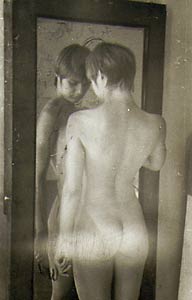"Boundaries",
"Spider & Mouse" Gallery, Moscow
"Denotation of a body", performance
 Aug. 1995. Workshops “INTERSTUDIO”, Zapasny Palace, Tsarskoe Selo
Aug. 1995. Workshops “INTERSTUDIO”, Zapasny Palace, Tsarskoe Selo
“The Denotation of a Body”
Performance
Materials:
Mirror, marker, stickers with various images.
Action:
I strip off slowly in front of the window.
One by one I name each part of my body.
I write the names of body parts on the mirror.
I encircle them erasing the inscriptions.
I create my mirror “look-alike”.
I glue on stickers with images on the obtained picture
I dress myself.
Duration: 45 minutes
P.S. Performance is produced in front of a video camera and with
no audience.
The mirror body of Liza Morozova
Sergei Seregin
When Alice looked into the mirror, she couldn’t see herself in
it, and even if she could, she wouldn’t recognise herself. And
she is perfectly right in her non-recognition, because the one
who is not self is the Other (A-Lice), more so if the one is behind
the glass. A kitten or a puppy usually tries to touch the reflection
or look behind the mirror: they assume that the other kitten or
puppy plays with them. Alice, if we are loyal to Carroll, in fact
can see everything except her own double. She doesn’t need this
reflection, she accepts herself entirely, she is not going to
distance from herself in order to look at Alice from the outside.
In our case Liza-child doesn’t need to examine the behind-the-mirror
A-Liza. One recognises oneself not in the reflection but in the
feeling “I exist here and now”.
As long as the self which can be detached from the whole is absent,
so is the necessity of the Other. Or like this: as long as the
centre and the periphery are merged with the self, the boundary
between the self and the Other doesn’t exist. The Other is no
more than a territory occupied by the self. The cognition of the
self comes not through examination but through feeling and touching
when self communicates with self. Here there is no such a thing
as body as yet (at least not as a question or a problem), just
one self flying through the Emptiness. Maybe that’s why kids don’t
make performances or to be more precise the only thing they do
is performance - they live in the condition of performance.
Self-identification goes in parallel with the discrediting of
the original continuous wholeness of the self, which presupposes
itself as a centre and is able to detach itself from the body,
detach its own body as a body of the Other. It is this Other that
the self wants to recognise in the mirror. Moreover, the self
which desires to return to the continuous wholeness of the self,
must accept the Other, appropriate it as Self/Other. Prior to
this it has to detach the Other from the self completely and thus
recreate, so that the self and the Other could merge.
Liza’s “mirror” performance could be read as a ritual, which
embraces several stages:
Stage 1. Preparation of the ritual space and attributes of the
ritual
Stage 2. Undressing as the strongest indication of sociality
– desocialisation of the body. Removal of the cross – return of
the Other to exodus, to the pre-religious condition of the new-born
baby – regression and emancipation of the body from the care of
the divine powers.
Stage 3. Bringing various parts of the new twin-body into being,
verbal denotation (naming), written (non-verbal) denotation, creating
(drawing) the ideal twin-body on the model of the old one – because
the new body should possess all qualities of the old one, so that
the continuity of time is not interrupted.
Stage 4. Rebirth of the body through animation of the twin-body
and through merging the animated ideal body with the self.
Stage 5. Symbolisation of the twin-body as an archetype of corporality.
The self appropriated the body of the Other. Liza retreats from
the mirror, but now there is an ideal twin-body, body-archetype
– the new Other in the mirror. There is always a temptation to
overturn the opposition – to suggest that Liza (self) and A-Liza
(Other) swapped their roles. And do I really know where the self
is – to this or the other side of the mirror? And what is left
of the body which went through these mirror perturbations? Maybe
a smile of the Cheshire Cat? Or just a smile? Perhaps, a slightly
sad one…
“Boundaries” Exhibition catalogue, Spider&Mouse Gallery,
Moscow, Sep. 1995
|

